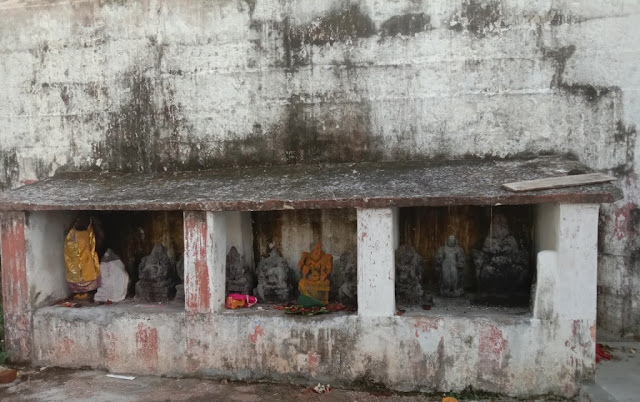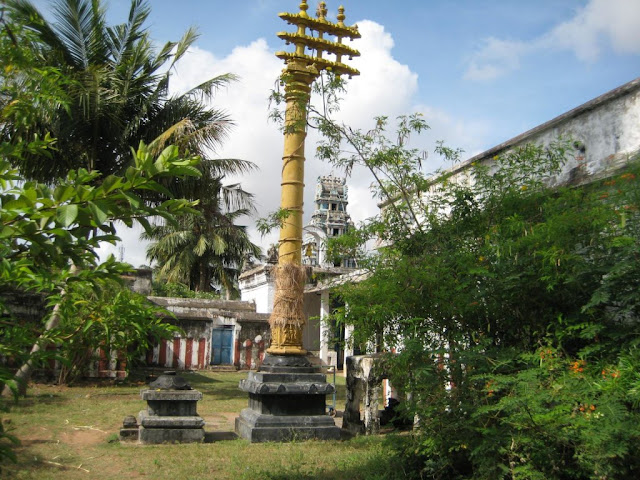Brahma
Temple, Kumbakonam,
Thanjavur
Brahma
Temple is a Hindu Temple dedicated to Lord Vishnu
located in Kumbakonam Town in Thanjavur District in Tamil Nadu. Presiding deity is
called as Veda Narayana Perumal and Mother is called as Veda Valli Thayar. Though the temple is dedicated to Vishnu, this
temple is generally known as Brahma Temple.
Legends
Once,
Lord Brahma became arrogant thinking that he was the only person capable of
creation and was superior to both Shiva and Vishnu. Lord Vishnu sent a ghost
(Bhooda) to Brahma who trembled on seeing the creature. He ran to Lord Vishnu
saying that a ghost not created by him was threatening and sought protection. Lord
Vishnu said that it was created by him to check his pride and that he would
also forget the art of creation. When begged for a remedy, Lord Vishnu
suggested that he should go to Earth and perform penance.
Lord Brahma
chose Kumbakonam that stays stable even after the destroying Pralaya floods.
All the Devas assisted Brahma in his penance. Pleased with Brahma’s penance,
Lord Vishnu appeared before him, taught the Vedas and reinstated Brahma to his
earlier status. Hence, he came to be called as Veda Narayana Perumal and Mother
came to be called as Vedavalli. To facilitate the final bath of Lord Brahma and
the Devas after the penance, Lord Vishnu created a river with his club known as
Hari Sollaru. It got corrupted to Arasalaru today.
The
Temple
This
is a small Temple with an entrance arch with stucco images of Narayana Perumal,
Brahma and Yoga Narasimha with their consorts respectively. Though the temple
is dedicated to Vishnu, this temple is generally known as Brahma Temple.
Presiding deity is called as Veda Narayana Perumal. He is housed in the
sanctum. He is flanked by his consorts Sridevi and Bhoodevi. He is in sitting
posture.
There
is a separate shrine for Lord Brahma to the right side of the sanctum. He is
flanked by Saraswathi and Gayatri. He is in standing posture. He is having
four faces. However, the fourth face which is in the back, is generally covered
by a cloth. The fourth face could be seen as a reflection in the mirror
behind the idol and it is the face of Mother Gayathri.
There
is a shrine for Yoga Narasimha to the left side of the sanctum. He is gracing
the devotees along with his consorts Sridevi and Bhoodevi. It is unique as the
Lord is present with two Thayars, generally Narasimhar is seen with Lakshmi
only. There is a separate shrine for Vedavalli Thayar, the consort of Veda
Narayana Perumal, in the prakaram. There are shrines for Srinivasa Perumal,
Dhanvatri and Andal in the Temple premises.
Temple
Opening Time
The
temple remains open from 08.00 a.m. to 11.30 a.m. and from 05.30 p.m. to 09.00
p.m.
Pooja
Timings
|
Poojas
|
Timings
|
|
1. Vishwarupa
|
08.15
am
|
|
2. Kaala
Sandhi
|
09.30
am
|
|
3. Uchi
Kaalam
|
11.30
am
|
|
4.
Nithyanu Santhanam
|
06.30
pm
|
|
5. Aaradhanam
|
07.30
pm
|
|
6.
Artha Jamam
|
09.00
pm
|
Festivals
Vaikuntha
Ekadasi and Saraswathi Pooja are the festivals celebrated here with much
fanfare.
Prayers
Devotees
perform special pujas for Lord Brahma and Mothers Saraswathi and Gayatri before
admitting children to school. Special pujas are performed during Thursdays.
Pujas are performed for Mother Mahalakshmi on Fridays and Perumal on Saturdays
for relief from debt burdens. Homas are performed for Lord Yoga Narasimha by
devotees for longevity on their 60th, 70th and 80th
birthday occasions. Devotees perform abishek to Lord and Mother offering
vastras.
Contact
Veda
Narayana Perumal Temple (Brahma Temple),
Kumbakonam,
Thanjavur District – 612 001
Mobile: +91 94865 68160
Connectivity
For brief details, please refer below link;
https://tamilnadu-favtourism.blogspot.com/2021/10/brahma-temple-kumbakonam-connectivity.html
Location

































